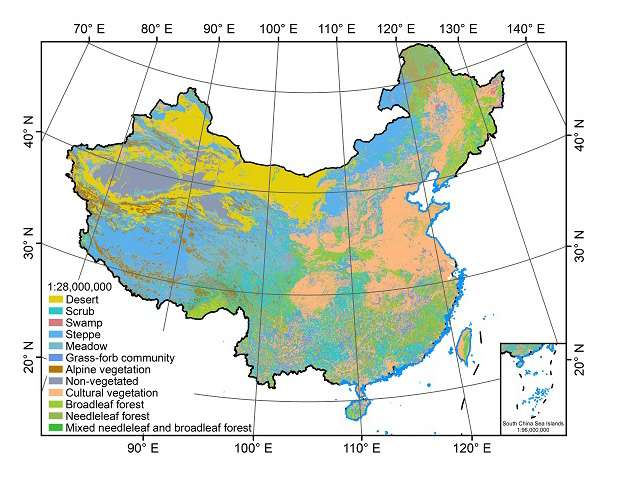Vegetation maps provide crucial information for ecological studies, biodiversity conservation, vegetation management and restoration, and for national strategic decision making. The current vegetation map of China at a scale of 1:1000000 was produced by a team of more than 250 scientists over the course of two decades starting in the 1980s. However, China has experienced rapid development during the last three decades, and its vegetation distribution has changed drastically due to climate change and anthropogenic activities. The vegetation map of China urgently needs to be updated to improve the understanding and management of China’s terrestrial ecosystems.
Traditional vegetation maps have mapped the potential vegetation distributions through the combination of field surveys, expert knowledge, and literature reviews. With the development of remote sensing technologies, it has become possible to collect large-scale land surface observations in an efficient and repeatable way, which has greatly changed the vegetation mapping strategy. China contains large diversity in vegetation types due to its vast topological and climatic variability, and accurately mapping the distribution of different vegetation types of China has been an essential but difficult task for the Chinese scientific community using traditional methods. This project developed a crowd sourcing change detection-classification-expert knowledge” vegetation mapping strategy and tried to update the vegetation map of China (1:1000000).
Enormous field samples are needed both for training a classifier and for validating the vegetation mapping results. A mobile phone application and an online web system were developed to collect and manage crowd sourced field samples. Together with field plots, a total of 203,024 field samples were collected. Finally, 50 taxonomists were involved in the validation and correction of the updated vegetation map based on their expert knowledge.

Figure 1. Distribution of collected field samples used for updating the Vegetation Map of China.

Figure 2. The updated Vegetation Map of China (1:1000000) presented at the vegetation group type level.
The resulting updated map has 12 vegetation type groups, 55 vegetation types/subtypes, and 866 vegetation formation/sub-formation types. The overall accuracy and kappa coefficient of the updated map are 64.8% and 0.52 at the vegetation type group level, 61% and 0.55 at the vegetation type/subtype level and 40% and 0.38 at the vegetation formation/sub-formation level. When compared to the original map, the updated map shows that 3.3 million km2 of China’s vegetated area has changed it vegetation type group during the past three decades due to anthropogenic activities and climatic change. The updated map is an important vegetation map product since the accuracy of the update map is much higher than that of the original map, especially in the areas that have changed . Currently, this project is working on making the new generation of Vegetation Map of China (1:500000). However, it may still need at least five to six years before the new vegetation map of China is produced. Before then, the resulting updated map in this study could better represent the current vegetation status of China and therefore serve better in ecological studies and managements and national strategic decision making.
This work was supported by the Strategic Priority Research Program of Chinese Academy of Sciences (XDA19050401) and had been published in Science Bulletin. This project is still working on making the new generation of Vegetation Map of China (1:500000) and can ultimately result in a much more detailed and accurate vegetation map of China.
References:
Su Y J, Guo Q H*, Hu T Y, et al. An Updated Vegetation Map of China (1: 1000000). Science Bulletin, 2020. https://doi.org/10.1016/j.scib.2020.04.004 (in pres

